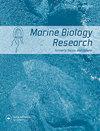黑海东南部鳕鱼(Merlangius merlangus)的长重关系和饮食组成的季节变化
IF 1.2
4区 生物学
Q4 ECOLOGY
引用次数: 0
摘要
摘要研究了土耳其黑海东南部白鲑(Merlangius merlangus)的性别比、长重关系(LWR)和基于胃内容物的饲粮。2017年2月至12月,每月取样共捕获雌性(7.5 ~ 24.0 cm) 3507条,雄性(9.4 ~ 20.0 cm) 1602条,性别不明(5.5 ~ 16.5 cm) 78条。雌雄比以雌鼠为主,雌雄比(♀:♂,1:0.46)明显偏离1:1。LWR显示雄性呈负异速生长,而雌性呈正异速生长。基于相对重要指数(IRI%)的胃内容物分析表明,以Sprattus Sprattus和Engraulis encrasicolus为优势的纯鱼食性饵料占merlangus总饵料的91%以上。修正后的Costello-Amundsen图解分析证明了墨氏田鼠在整个研究过程中的特殊摄食策略。这两种猎物对麦氏沼虾食性的贡献表现出相当大的季节变化,这完全取决于它们的丰度。在6、7、8月份,Sprattus Sprattus贡献了超过98%的日粮,而在接下来的几个月中,E. encrasicolus开始占据其位置。根据鱼的大小,猎物多样性随鱼的大小增加而增加。此外,随着捕食者规模的增加,sprattus的贡献呈下降趋势,取而代之的是ecrasicolus的贡献增加。因此,体型较大的merlangus主要以棘足鼠为食,而体型较小的捕食者则倾向于以棘足鼠为食。本文章由计算机程序翻译,如有差异,请以英文原文为准。
Length–weight relationship and seasonal variations in diet composition of whiting (Merlangius merlangus) in the South-eastern Black Sea
ABSTRACT The sex ratio, length–weight relationship (LWR) and diets based on stomach contents of whiting (Merlangius merlangus) were investigated in the south-eastern Black Sea, Turkey. A total of 3507 females (7.5–24.0 cm), 1602 males (9.4–20.0 cm), and 78 unidentified sex (5.5–16.5 cm) whiting were caught during monthly sampling from February to December 2017. The sex ratio was dominated by females, and their ratio (♀:♂, 1:0.46) significantly deviated from 1:1. The LWR indicated a negative allometric growth for males, while females had a positive allometric growth pattern. The stomach content analysis based on the relative importance index (IRI%) indicated exclusively piscivorous diets dominant by Sprattus sprattus and Engraulis encrasicolus made up more than 91 IRI% of the total diets of M. merlangus. The modified Costello-Amundsen’s graphical analyses evinced the specialized feeding strategy of M. merlangus throughout this study. The contribution of these two preys to the diets of M. merlangus showed considerable seasonal variations that were totally dependent on their abundance. Sprattus sprattus contributed to more than 98% of the total diets during June, July and August, while in the following months, E. encrasicolus appeared to take its position. Based on fish size, a general trend of a rise in prey diversity was found with increasing fish size. Also, the contribution of S. sprattus tended to decrease with increasing predator size, which is replaced by a rise in E. encrasicolus contribution. Hence, larger M. merlangus predominantly fed on E. encrasicolus while smaller size predators preferred to feed on S. sprattus.
求助全文
通过发布文献求助,成功后即可免费获取论文全文。
去求助
来源期刊

Marine Biology Research
生物-海洋与淡水生物学
CiteScore
2.10
自引率
0.00%
发文量
55
审稿时长
6-12 weeks
期刊介绍:
Marine Biology Research (MBRJ) provides a worldwide forum for key information, ideas and discussion on all areas of marine biology and biological oceanography. Founded in 2005 as a merger of two Scandinavian journals, Sarsia and Ophelia, MBRJ is based today at the Institute of Marine Research, Bergen, Norway. The Journal’s scope encompasses basic and applied research from all oceans and marine habitats and on all marine organisms, the main criterium for acceptance being quality.
 求助内容:
求助内容: 应助结果提醒方式:
应助结果提醒方式:


